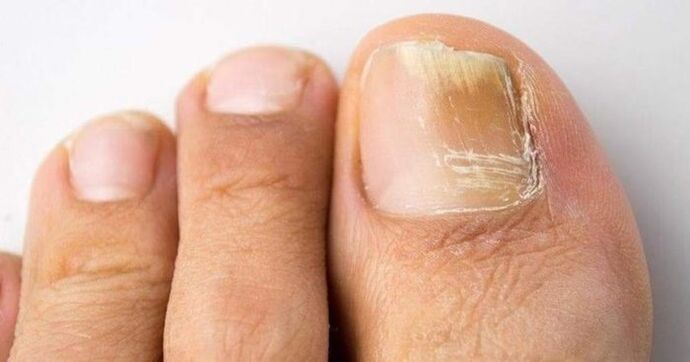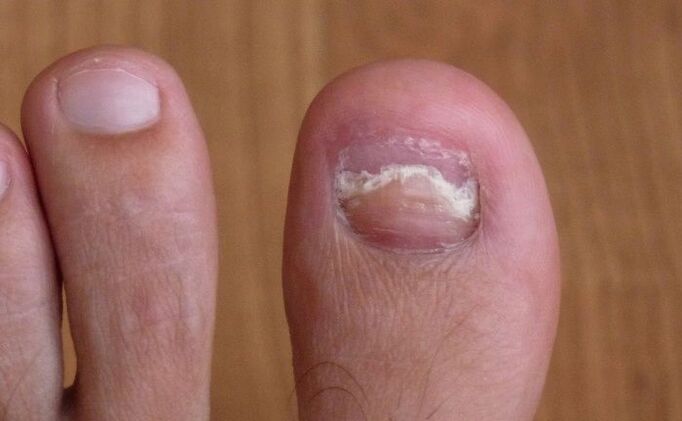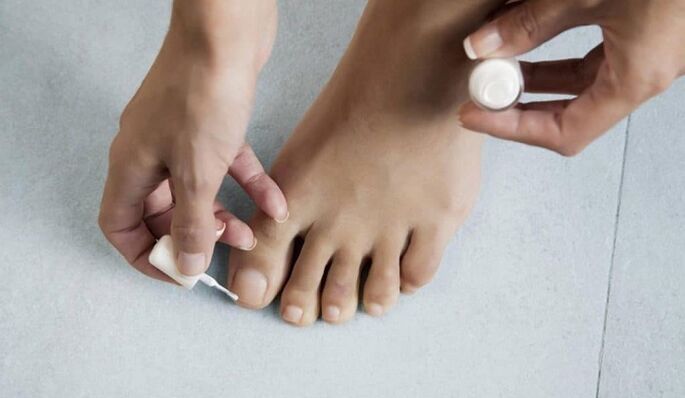Fungal disease can affect various tissues of the body, even internal organs. If the disease has already affected the nail, it is called onychomycosis. Its appearance is caused by a fungal microorganism.
They are divided into different genera: candidiasis, mold, dermatosis. Literally, the parasite eats the nail, leading to its premature destruction. Mycosis does not go away on its own. This is only possible with the most active of the immune system and the early stages of the disease, when symptoms are not seen. If the symptoms appear, you can be sure they won't go anywhere without treatment.

Reason appeared
Fungal microorganisms belong to the class of irritants. They are extremely tenacious. They quickly penetrate tissues, adapting to a variety of conditions. This is due to the complexity of the treatment of the disease. If you use the same drug for a long time, the parasite may stop responding to it.
The only reason for the appearance of the disease is fungal infestation on the nail. However, there are factors that are conducive to its early introduction and subsequent regeneration. Microorganisms are more likely to penetrate tissues if they have corn. Even dry skin can lead to tiny cracks, through which the fungus can easily penetrate. This microorganism "prefers" wet conditions, and is therefore actively spread among people who prefer tight shoes made of poor material that do not allow air to pass through.
Most often, toenail fungus in the big toe occurs on the basis of various pathologies:
- Endocrine diseases;
- Psoriasis;
- Varicose veins;
- Vascular disease;
- HIV and AIDS;
- Problems with metabolism;
- Eczema;
- Dermatitis;
- Skin infectious processes.
The microorganisms in fungi can enter the plate in the following ways:
- Contact with a carrier;
- Visiting public baths, saunas, showers;
- Wear someone else's sandals (for example, at a party);
- Living with someone with a fungal disease;
- Try on shoes;
- Use unpasteurized pedicure tools;
- Visit the beauty salon.
Factors that provoke the appearance of fungi are also:
- Lack of adequate personal hygiene;
- Priority is given to synthetic goods;
- Wear tight shoes that don't let the skin "breathe";
- Excessive obesity;
- Drink alcohol regularly;
- Elderly.
The disease will have more prominent manifestations if the patient has circulatory disorders in the foot area. In addition, changes in acid balance observed when taking antibiotics can lead to pathological processes.
Stages of the disease
The surface under the nail is very favorable for fungal microorganisms to grow. It contains many nutrients that the parasites ingest. Over time due to the impact of bacteria leads to destruction of the nail plate. Bunctures begin to form, during which the mycelium multiplies. There are the following stages of the disease:
- Initially.Refers to the type of autoimmune damage. Major damage affects the center or edge of the sheet. Spots and streaks appear, gradually starting to develop;
- Average.Represents hypertrophic changes. This stage is characterized by thickening of the foundation, changes in structure, and direction of development. Pathological processes gradually spread throughout the plaque;
- Dystrophy stage.For the listed procedures, inflammation in the nail fold area is added. Pus may drain out. Lesions spread to nearby skin. Additional bacterial infection speeds up the nail destruction process. It begins to crumble, possibly peeling off the nail bed.
When they first started out, the symptoms were negligible, so people often take the disease lightly. However, it is progressing rapidly. Very quickly, the spots that have arisen will begin to develop. It can be spread from one thumb to another.
If only the thumbnail is affected, it is usually mild to moderate. Therapy should be initiated immediately.

The symptoms
Symptoms vary widely depending on the stage of the disease. In the first place, the signs of a threat are almost imperceptible. With the development of the disease, the following symptoms can be observed:
- Mild itching;
- The area of the thumb is red and red;
- Burning sensation.
But the pathological process does not stand still. Its growth can be assessed by the following characteristics:
- The sheet is brittle, loses its natural shine;
- Acquire yellow, blue, or green in color (depending on the type of fungal microorganism that affects the nail);
- Marked spots and stripes appear;
- The nail grows with its angles to the roller, which is proof of the deformation of its growth.
During the severe stage, the following symptoms can be:
- Pain syndrome when walking;
- The appearance of swelling of the finger, its marked redness;
- Pus discharge under the edge.
The signs of female toenail fungus can be different depending on the fungus that causes the infection. For example, if it's a mold, the disease is very pronounced. Nails can literally turn black. There is swelling, silver scales, yellow edged. Sheets begin to move out of bed, which causes a severe discomfort. However, in 95% of cases the cause of the infection is a fungal skin bacteria. They are characterized by a relatively moderate course of illness.
This disease not only affects the nails but also affects the entire body. This is due to the fact that toxins get into the lymph channels. This results in the following changes:
- Allergic reactions, the appearance of a rash on the skin;
- Gastro-intestinal problems;
- Signs of intoxication.
If nothing is done with the severe stage of the fungal disease, the damage can spread to internal organs. This is extremely dangerous.
How is the treatment performed?
How to cure toenail fungus? Pathogenic microorganisms are distinguished by their enviable tolerance to various influences. They quickly took root in them and began to multiply actively. Therefore, it is desirable to perform a full-fledged antifungal therapy. It includes:
- Use local funds. It can be ointments, drops, medicated varnishes, solution. They are required to defeat the disease on a superficial level. Among the local remedies are lacquer, hemoglobin;
- Systemic drugs. They are used for significant lesions of the nail plate. The pills are used daily. Effective pulse therapy. It involves taking short-term medication for a long time. Then the course is repeated. It should be noted that the drug cannot be taken in all cases. Do not use them in the early stages of the disease. These funds are quite strong, and therefore have contraindications: pregnancy, childhood, renal failure, intolerance of components.
The disease is often accompanied by complications caused by bacteria. You can also be safe from them. Antifungal varnish is perfect for this purpose. It creates a film on the surface of the sheet through which bacteria cannot penetrate.
In addition, it is necessary to stimulate the body's defensive targets, which will be aimed towards fighting infection. For this, vitamin complexes, immunomodulatory drugs are used.
Most drugs have a cumulative effect. It is not enough to take them once and forget about therapy. Complete the required course.
It does not end even if all symptoms are gone. The active substances accumulate in the lips and continue to work even after the end of the pill.
Another additional procedure is the nail removal. Is involved in strong pathological processes. Removal can be done using urea-containing specialty products. If the sheet is hard, there will be some procedures to remove it completely. Do not be afraid of removal as it is painless. Once removed, you need to treat the surface with an antiseptic. Removal is very convenient because then, local remedies can be applied directly to the nail layer. This greatly improves their efficiency.

Traditional method
Folk remedies cannot replace medicine. But they are suitable for extra help. The following ingredients help the fungus:
- Iodine.Affected area should be lubricated with iodine twice a day. If there is a burning sensation, you need to remove all excess substances and reduce the dose;
- Lemon.A slice of lemon is applied to the affected area, then it is fixed with ice. Cellophane is put on top;
- Hydrogen peroxide.A cotton pad is dampened in hydrogen peroxide, then it is fixed on the nail for 30 minutes. Softened areas can be removed.
After all these procedures, treatment with antibacterial topical drugs is desirable.
Precautions
It's important to follow precautions not just for someone who doesn't want a fungal infection. They are basic for people who have just recovered from the disease. Precautions include the following rules:
- Adhere to personal hygiene;
- Foot bath daily;
- Lubricate your feet with pedicure, moisturizer;
- Use personal sandals;
- Treat your nails with preventive medicine before taking a bath or shower. You can replace the specialty product with lemon juice.
The preventive measures for new fungal infections are even more stringent:
- Use once a week a topical remedy for fungus;
- Regularly use hot foot baths supplemented with sea salt;
- Treat shoes with antifungal compounds;
- Sock boiling, in which there is complete destruction of microorganisms;
- You should continue to take vitamins;
- Bath surface is disinfected. All other indoor surfaces should be treated.
Prevention with a high probability protects against fungal disease. You just need to monitor the condition of your feet. If unclear signs reappear, you should immediately consult a doctor. Self-medication is not recommended as fungal diseases are easily confused with other problems. In this case, the wrong treatment is chosen, and the disease will continue to progress. All of this is fraught with great future problems. Reception of system funds, without fail, is performed under the supervision of a physician.



























